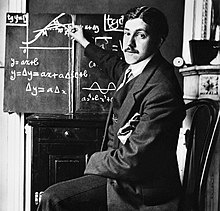Marcel Dassault
Marcel Dassault | |
|---|---|
 Marcel Bloch in 1914 | |
| Born | Marcel Bloch January 22, 1892 Paris, France |
| Died | April 17, 1986 (aged 94) Neuilly-sur-Seine, France |
| Resting place | Passy Cemetery |
| Nationality | French |
| Alma mater | Breguet School Supaéro |
| Occupation | aircraft industrialist |
| Known for | founding Dassault Aviation |
Marcel Dassault, born Marcel Bloch (22 January 1892 – 17 April 1986), was a French aircraft industrialist.
Biography
Dassault was born in Paris. After graduating from the lycée Condorcet, Breguet School, and Supaéro, he invented a type of aircraft propeller used by the French army during World War I and founded the Société des Avions Marcel Bloch aircraft company. Following the nationalization of his company in 1936, under the Front Populaire, he stayed as a director. In 1919, he married Madeline Minckes, the daughter of a wealthy Jewish family of furniture dealers.[1] They had two sons, Claude and Serge.
Being of Jewish heritage and after refusing collaboration with the German aviation industry, he was deported to Buchenwald during World War II while his wife was interned near Paris. He changed his name from Bloch to Bloch-Dassault and, in 1949, to simply Dassault. Dassault was the codename used by his brother, General Darius Paul Bloch, when he served in the French resistance, and is derived from char d'assault, French for "battle tank".[note 1] Marcel Dassault converted to Roman Catholicism in 1950.[2][3] After the war, he built the foremost military aircraft manufacturer in France, Avions Marcel Dassault. The firm is now the Groupe Industriel Marcel Dassault, whose CEO is Serge Dassault, Marcel's son.
From the Sabatier d'Espeyran family, Marcel Dassault purchased the buildings at nos. 7 and 9 rond-point des Champs-Elysées at the angle of the avenue des Champs-Élysées and avenue Montaigne in Paris. The impressive structure at no. 7, built in 1888, has been altered over the years including by Dassault's friend, architect Georges Hennequin (1893—1969), when Dassault acquired the buildings in July 1952. (The neo-Louis XV-style domicile at no. 7, first as the Hôtel d'Espeyran, was built by architect Henri Parent for Félicie Durand [1819-1899], the widow of Frédéric Sabatier d'Espeyran [1813-1864].) Now known as the Hôtel Marcel Dassault, the building at no. 7 has been occupied from 2002 by auction house Artcurial, which further made alterations according to plans by architect Jean-Michel Wilmotte. The structure at no. 9 continues to be occupied by the Groupe Industriel Marcel Dassault.
Marcel Dassault died at Neuilly-sur-Seine in 1986 and was buried in the Passy Cemetery in the 16th arrondissement of Paris.
Notes
- ^ char d'assault means "battle tank" in French, but a word-for-word translation would be "assault wagon". D'assault simply means "for assault".
See also
- Societé des Avions Marcel Bloch
- Dassault Group
- Dassault Aviation
- The Talisman: the Autobiography of Marcel Dassault, Creator of the Mirage jet, translated by Patricia High Painton. New Rochelle, N.Y.: Arlington House, 1971 ISBN 0-87000-149-3
References
- ^ Ottawa Citizen, "Madame a Prisoner Before" May 25, 1964
- ^ "History of Groupe Dassault Aviation". Retrieved 1 October 2012.
- ^ Britannica Online: Marcel Dassault retrieved February 23, 2012
External links
- 1892 births
- 1986 deaths
- Businesspeople from Paris
- French aerospace engineers
- Supaéro alumni
- Businesspeople in aviation
- French industrialists
- French inventors
- French Jews
- Buchenwald concentration camp survivors
- Burials at Passy Cemetery
- French Roman Catholics
- Converts to Roman Catholicism from Judaism
- Lycée Condorcet alumni
- Great Medal of the Aéro-Club de France winners
